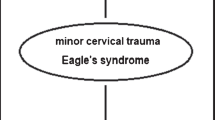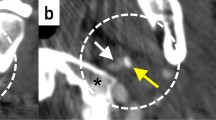Abstract
Introduction
To look for the presence and strength of association of cervical carotid artery dissection (CCAD) with a long styloid process.
Methods
This case–control analysis included 35 patients with 37 affected carotid arteries. CT angiograms of these patients were analyzed by two raters blinded to clinical and radiological diagnosis. Parameters assessed were styloid process length, its proximity to the cervical internal carotid artery, and its medial and anterior angulations. The same parameters were assessed in 70 CT angiograms in age and sex matched controls.
Results
Interrater correlations were 0.87, 0.40, 0.71, and 0.79 for styloid process length, contact distance, medial angulation, and anterior angulation, respectively. The mean styloid process length on the affected side was significantly more than on the contralateral side (37.8 vs. 34.6 mm, p = 0.006). There were also significant length and contact distance differences between the styloid processes ipsilateral to dissection and ipsilateral styloid processes of controls (38.9 vs. 36.2 mm, p = 0.05 and 3.1 vs. 5.0 mm, p = 0.05, respectively). There were increasing odds ratios (OR) for dissection with increasing styloid process length, with OR of 4.36 (95 % CI = 1.04 to 18.4, p = 0.04) for length more than 50 mm. ORs for dissection increased with decreasing contact distance, with OR for distances less than 5 mm being 7.58 (95 % CI = 0.93 to 62.1, p = 0.06). There was no significant association of CCAD with angulation of the styloid process.
Conclusion
Length and contact distance of the styloid process are risk factors for CCAD, suggesting mechanical impingement.




Similar content being viewed by others
References
Debette S, Leys D (2009) Cervical artery dissections: predisposing factors, diagnosis, and outcome. Lancet Neurol 8:668–678
Micheli S, Paciaroni M, Corea F, Agnelli G, Zampolini M, Caso V (2010) Cervical artery dissection: emerging risk factors. Open Neurol J 4:50–55
Rodallec MH, Marteau V, Gerber S, Desmottes L, Zins M (2008) Craniocervical arterial dissection: spectrum of imaging findings and differential diagnosis. Radiographics 28:1711–1728
Rubinstein SM, Peerdeman SM, van Tulder MW, Riphagen I, Haldeman S (2005) A systematic review of the risk factors for cervical artery dissection. Stroke 36:1575–1580
Soo OY, Chan YL, Wong KS (2004) Carotid artery dissection after prolonged head tilting while holding a newborn baby to sleep. Neurology 62:1647–1648
Zuber M, Meder JF, Mas JL (1999) Carotid artery dissection due to elongated styloid process. Neurology 53:1886–1887
Chuang WC, Short JH, McKinney AM, Anker L, Knoll B, McKinney ZJ (2007) Reversible left hemispheric ischemia secondary to carotid compression in Eagle syndrome: surgical and CT angiographic correlation. AJNR Am J Neuroradiol 28:143–145
Basekim CC, Mutlu H, Gungor A, Silit E, Pekkafali Z, Kutlay M et al (2005) Evaluation of styloid process by three-dimensional computed tomography. Eur Radiol 15:134–139
Piagkou M, Anagnostopoulou S, Kouladouros K, Piagkos G (2009) Eagle’s syndrome: a review of the literature. Clin Anat 22:545–558
Faivre A, Abdelfettah Z, Rodriguez S, Nicoli F (2009) Bilateral internal carotid artery dissection due to elongated styloid processes and shaking dancing. J Neurol Neurosurg Psychiatry 80:1154–1155
Raser JM, Mullen MT, Kasner SE, Cucchiara BL, Messé SR (2011) Cervical carotid artery dissection is associated with styloid process length. Neurology 77:2061–2066
Keshelava G, Nachkepia M, Arabidze G, Janashia G, Beselia K (2012) Unusual positional compression of the internal carotid artery causes carotid thrombosis and cerebral ischemia. Ann Vasc Surg 26:572e15–7
Jung T, Tschermitschek H, Hippen H, Schneider B, Borchers L (2004) Elongated styloid process: when is it really elongated? Dentomaxillofac Radiol 33:119–124
More CB, Asrani MK (2010) Evaluation of the styloid process on digital panoramic radiographs. Indian J Radiol Imaging 20:261–265
Etesami M, Qiao Y, Wityk RJ, Wasserman BA (2011) Signal characteristic alterations of carotid artery dissection on high resolution magnetic resonance imaging: a follow-up study. J Cardiovasc Magn Reson 13:393. doi:10.1186/1532-429X-13-S1-P393
Conflict of interest
We declare that we have no conflict of interest.
Author information
Authors and Affiliations
Corresponding author
Rights and permissions
About this article
Cite this article
Muthusami, P., Kesavadas, C., Sylaja, P.N. et al. Implicating the long styloid process in cervical carotid artery dissection. Neuroradiology 55, 861–867 (2013). https://doi.org/10.1007/s00234-013-1186-1
Received:
Accepted:
Published:
Issue Date:
DOI: https://doi.org/10.1007/s00234-013-1186-1




